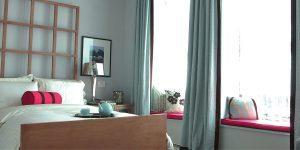 When it comes to selecting an interior paint for your home, there’s more to consider than quality and color. Most paints come in a variety of sheen levels – as many as six, depending upon the brand – and some are better suited for certain rooms than for others, according to Debbie Zimmer, paint and color expert at the Paint Quality Institute.
When it comes to selecting an interior paint for your home, there’s more to consider than quality and color. Most paints come in a variety of sheen levels – as many as six, depending upon the brand – and some are better suited for certain rooms than for others, according to Debbie Zimmer, paint and color expert at the Paint Quality Institute.
Paints with flat sheen are most common. They offer several advantages: being non-reflective, they tend to conceal imperfections in walls and other surfaces; they help to make uneven surfaces like poorly taped drywall look smoother and more uniform; and many hide the under-color well, since they typically contain a lot of pigment.
“Flat paints are a good choice for just about any ceiling, and for rooms and spaces that aren’t exposed to water, high humidity, or heavy soiling. . .such as bedrooms, home offices, and living rooms,” says Zimmer.
At the other end of the sheen spectrum are paints with gloss or high gloss sheen. Being very reflective, gloss paints tend to highlight imperfections in walls and woodwork. But they are especially tough, durable, and stain-resistant – and, they are much easier to clean than paints with less gloss.
Zimmer advises that high gloss finishes are ideal for use on windows and trim, children’s rooms, and playrooms. And since they have better resistance to mildew, they also are a great choice for bathrooms, kitchens, and laundry rooms.
Paints with semi-gloss sheen are a smart compromise between the two sheen extremes, providing some of the benefits of each. Since they are not as highly reflective as gloss paints, they won’t show surface imperfections quite as much; yet they still offer good stain resistance and are easy to clean.
“Semi-gloss paints are extremely versatile, working well on windows and doors, trim, even cabinets,” says Zimmer. “They can even be used on the walls of kitchens and baths, and various surfaces in children’s rooms and playrooms.”
Most lines of paint have at least a couple more sheen levels from which to choose. The descriptions vary, with eggshell, satin, and low luster sheen being the most common. Again, the best way to think of these sheen levels is in terms of their performance: Being less “shiny” than either gloss or semi-gloss paints, they won’t highlight nicks and surface imperfections quite as much, but since they have at least a little gloss, they’ll be easier to clean than flat paints.
Where to use eggshell, satin and low luster paints? According to Zimmer, paints in these sheen levels pretty much have the run of the house, working well just about anywhere you need the blend of performance attributes they offer.
At first blush, it may seem confusing having to choose from so many sheen levels. But once you understand what each has to offer, you’ll appreciate the luxury of being able to “calibrate” the exact combination of paint attributes you want in every part of your home.
For more information on interior paints and sheen levels, visit the Paint Quality Institute blog at blog.paintquality.com or the Institute’s website at www.paintquality.com. ![]()
About the Paint Quality Institute (SM)
The Paint Quality Institute (SM) was formed by Rohm and Haas Company (now a wholly owned subsidiary of The Dow Chemical Company (“Dow”)) in 1989 to educate people on the advantages of using quality interior and exterior paints and coatings. The Paint Quality Institute’s goal is to provide information on the virtues of quality paint as well as color trends and decorating with paint through a variety of vehicles, including television appearances, newspaper and magazine articles, and instructional literature.
Please be sure to visit the Paint Quality Institute at www.paintquality.com.
About Dow
Dow (NYSE: DOW) combines the power of science and technology to passionately innovate what is essential to human progress. The Company connects chemistry and innovation with the principles of sustainability to help address many of the world’s most challenging problems such as the need for clean water, renewable energy generation and conservation, and increasing agricultural productivity. Dow’s diversified industry-leading portfolio of specialty chemical, advanced materials, agrosciences and plastics businesses delivers a broad range of technology-based products and solutions to customers in approximately 160 countries and in high growth sectors such as electronics, water, energy, coatings and agriculture. In 2011, Dow had annual sales of $60 billion and employed approximately 52,000 people worldwide. The Company’s more than 5,000 products are manufactured at 197 sites in 36 countries across the globe. References to “Dow” or the “Company” mean The Dow Chemical Company and its consolidated subsidiaries unless otherwise expressly noted. More information about Dow can be found at www.dow.com.




